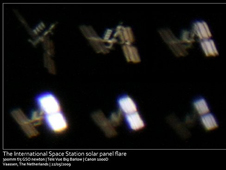天文马拉松:观测国际空间站
By 苏剑林 | 2009-07-09 | 20683位读者 |前言:也许你从未见过宇宙飞船,也许你躺在星空下却无所事事,也许你有望远镜却无观测对象,不过,这种心情可以结束了,因为我们可以观测国际空间站!对于这一新闻,无疑是令我们振奋人心的消息!对于天文爱好者来说,更是令人兴奋!不论如何,在繁星中寻找国际空间站是一件无比写意的事情。不仅是能力的挑战,还有耐心!
内容:
如果你没有亲眼看到过飞船,不要伤心,现在就有机会了。
最近,国际空间站(ISS)开始多次越过美国上空。从六月的第一个周末开始,一天之内,空间站已经连续地出现了1次、2次甚至3次。不论你住在哪里,你也会有机会看到有史以来最庞大的宇宙飞船。
国际空间站已经建设了11年,如今它已经变得非常巨大,而且十分明亮。空间站宽已经超过了350英尺(大于一个足球场),实验舱和居住舱的空间达到12600立方英尺,把它放到地球上,重达67万磅!阳光的照射使得这个大块头在夜晚异常明亮,亮度是最亮的恒星——天狼星的15倍! 有的时候甚至会更加明亮。当阳光照耀在空间站的平直表面(主要是太阳能电池阵列)上,会产生比天狼星还有亮600多倍的光芒。对于天文学家来说:国际空间站的目视星等为-8(注:目前最亮的星星是金星,一般为-4等左右,等级越小越明亮,肉眼一般可见的最暗星为-6等星)
“5月22日,空间站通过荷兰,在我住所附近的天文台上空,爆发出壮观的身影,”业余天文爱好者Quintus Oostendorp报告,“我知道国际空间站就要出现了,于是准备好我的望远镜,以便能让我精确看到究竟会发生什么。” 目前,景象的出现是无法预测的,没有人知道什么时候将会发生,也无法确定有多明亮,因为任一预定的地点都可能被工作人员中断——这就使得观测具有无比乐趣。 国际空间站的马拉松观测直到7月下旬才会停止(这取决于您的位置)。而奋进号航天飞机定于7月11日发射,到时候我们也许可以一睹奋进号的风采。在航天飞机与空间站对接后,许多观测家将见证一个难忘的时刻——一个双重飞越:奋进号与空间站并排在繁星点点的夜空!
奋进号会再次执行对空间站建设的任务。这一次将会为日本的Kibo科学试验舱带去一个“太空走廊(space porch)”。这个“走廊”并非提供给宇航员坐下、放松或看星流(尽管这不是一个坏主意)的,而是一个科学平台。当试验需要暴露在真空或高能辐射的太空时,可以把试验品放到“走廊”上带出外面,以利用国际空间站的独特的研究环境。这个“走廊”正式名称为“Kibo Japanese Experiment Module Exposed Facility”,意思大概是“基博日本试验舱舱外设施”,这样将会为夜晚中的国际空间站提供一点贡献,增加其一点点的亮度!
现在该做什么?查阅空间站时间和地点,准备你的望远镜(可选),然后开始吧!
查找国际空间站的飞行轨道:
http://spaceflight1.nasa.gov/realdata/sightings/
原文来自:http://www.nasa.gov/topics/shuttle_station/features/space_station_sighting.html
Space Station Marathon
If you've never seen a spaceship with your own eyes, now's your chance.
The International Space Station (ISS) has recently started a remarkable series of flybys over the United States. Beginning the first weekend of July, the station has been appearing once, twice, and sometimes three times a day successively. No matter where you live, you should have at least a few opportunities to see the biggest spaceship ever built.
The ISS has been under construction for nearly 11 years, and it has grown very large and very bright. The station is now more than 350 ft wide (wider than a football field), has 12,600 cubic feet of labs and living quarters, and on Earth would weigh about 670,000 lb. Sunlight illuminating the massive outpost makes it shine fifteen times brighter than Sirius, the brightest star in the sky.
Sometimes it is even brighter than that. Sunlight glinting from the station's flat surfaces (mainly solar arrays) produce dazzling flares as much as six hundred times brighter than Sirius. For astronomers: On the scale of visual magnitudes, space station flares register -8.
"The station flared spectacularly on May 22 when it passed over my backyard observatory in the Netherlands," reports amateur astronomer Quintus Oostendorp. "I knew the ISS was coming, so I had my telescope ready and I was able see exactly what happened."
At present, the flares are unpredictable. No one knows when they will happen or exactly how bright they will be. Any given flyby could be interrupted by one—and that's what makes the watch so much fun.
The marathon of space station flybys won't stop until mid-to-late July (depending on your location). That gives space shuttle Endeavour, currently scheduled to launch on July 11, time to reach the space station and join the show. As the shuttle approaches station for docking, many observers will witness a memorable double flyby—Endeavour and the ISS sailing side by side across the starry night sky.
Endeavour is on yet another space station construction mission. This time it will deliver a "space porch" to be added to Japan's Kibo science laboratory module. The porch is not a place where astronauts can sit, relax and watch the stars drift by (although that is not a bad idea); it is a science platform. When an experiment needs to be exposed to the hard vacuum or energetic radiation of space, it can placed outside on the porch to take advantage of the space station's unique research environment. The official name of the porch is the Kibo Japanese Experiment Module Exposed Facility and it will add its own small contribution to the station's reflected luminosity in the night sky.
What now? Check for flyby times, ready your telescope (optional), and let the sightings begin.
转载到请包括本文地址:https://www.spaces.ac.cn/archives/14
更详细的转载事宜请参考:《科学空间FAQ》
如果您还有什么疑惑或建议,欢迎在下方评论区继续讨论。
如果您觉得本文还不错,欢迎分享/打赏本文。打赏并非要从中获得收益,而是希望知道科学空间获得了多少读者的真心关注。当然,如果你无视它,也不会影响你的阅读。再次表示欢迎和感谢!
如果您需要引用本文,请参考:
苏剑林. (Jul. 09, 2009). 《天文马拉松:观测国际空间站 》[Blog post]. Retrieved from https://www.spaces.ac.cn/archives/14
@online{kexuefm-14,
title={天文马拉松:观测国际空间站},
author={苏剑林},
year={2009},
month={Jul},
url={\url{https://www.spaces.ac.cn/archives/14}},
}











最近评论